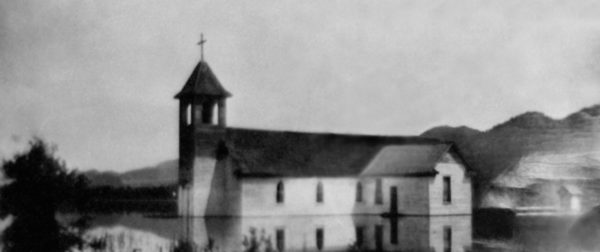Our Lady of Sorrows Church is a notable landmark on the Kalispel Tribe's 4,564-acre reservation in Pend Oreille County, northeastern Washington State. The reservation is located along the Pend Oreille River, about 55 miles north of Spokane. Built in 1914 by Fr. Joseph Griva, S.J., the church is a notable example of Carpenter Gothic architecture, a style common among Pioneer churches built by settlers in Washington and Oregon. Fr. Griva, a prolific church builder and circuit rider in the Inland Northwest, provided detailed designs for the church, which was constructed quickly by professional carpenters between February and August 1914. The church has recently been restored to its original infrastructure, preserving its historical integrity.
Fr. Joseph Griva was instrumental in building or repairing many churches from the 1890s to the 1920s. Of the churches he built from scratch, only Our Lady of Sorrows and St. Michael’s Mission in Inchelium remain standing. The introduction of Catholicism to the Kalispel Tribe by Jesuit missionaries in the early 19th century significantly influenced Kalispel Tribal Members, they sent delegations to St. Louis to request "black robes" to teach them. Over time, many Kalispel people have blended Catholic practices with their traditional spiritual beliefs, incorporating elements such as holy water and incense, which parallel their use of water and sweet grass in rituals.
The church was central to community life, hosting regular masses, catechism classes, and social events. However, attendance began to decline in the 1960s, reflecting national trends. Since the late 1970s, efforts to revive the church and community life have been ongoing, supported by tribal initiatives like the Healing Lodge of the Seven Nations and the Camas Institute. Originally located on a floodplain, the church was moved to higher ground after a massive flood in 1948. In a remarkable show of unity and strength, over 20 Tribal Members worked together to hoist the church onto large logs, using horses to pull it while the men continuously repositioned the logs to guide the church before it reached its new location.
Today, Our Lady of Sorrows Church sees only a few regular attendees, four of whom are Kalispel Tribal Members. Despite this, the church remains a symbol of the Kalispel Tribe’s historical and cultural journey, reflecting a blend of traditional and Catholic practices. The church's name, Our Lady of Sorrows, was chosen to reflect the devout faith and challenging circumstances of the Kalispel people at the time of its construction. This historical landmark, now restored to its original infrastructure, stands as a testament to the resilience and cultural synthesis of the Kalispel Tribe, marking a significant chapter in their spiritual and community life.












